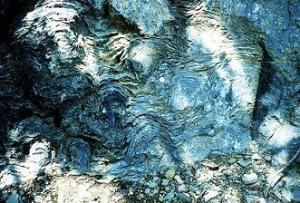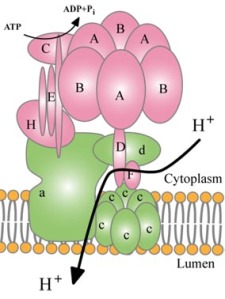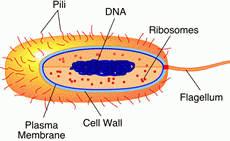If this was really a Levitican tale, there would have been a lot of laws in this piece, together, it has to be said, with a lot of references to splashing blood around. Instead, we are going to look at how life got a lift up in terms getting going, which will eventually gives us the blood to splash around at some point later on.
As we saw in the previous article, the creation of life from non-life (abiogenesis) is not well understood. Lots of theories, little proof so far. However once we have a working cell, we can invoke the power of evolution and let it rip. We don’t know quite what the first organisms looked like, but they were almost certainly single cell prokaryotic (without a nucleus – like bacteria) things, because that’s all we find in really old fossils. The earliest we have some sort of fossil record for, rather than faint chemical or isotopic traces, are stromatolites.
 These are sort of coral like structures, but made by bacteria. They grow in mats and trap particles between them and so lay down layered structures. Some still exist in some way out places around the world even today, Shark Bay in Australia for instance.
These are sort of coral like structures, but made by bacteria. They grow in mats and trap particles between them and so lay down layered structures. Some still exist in some way out places around the world even today, Shark Bay in Australia for instance.
These bacteria have learnt the trick of photosynthesis – converting the Suns energy into food. They use the power of light to split water into hydrogen and oxygen. Then, the hydrogen is used together with carbon dioxide to make up sugars. The oxygen is excreted as a rather dangerous by-product. The sugars can then be used later to make energy rich ATP molecules to be made to power internal systems. Some protein catalysts don’t need energy to work, they can just take substances A and B, and make C from them, just by being there. The down side of this is that they also tend to take substance C, and turn it right back into A and B too, given half a chance. If you can make the reaction require energy, you can make it more one way, and then you can make it more permanent.
The other trick these bacteria learnt early on was the proton pump. This may well have been an even earlier invention that the light powered reactions. Proton pumps are widely used in all manner of cases, and if you didn’t have enormous numbers of them in you, you’d die within short order.
 Proton pumps allow the transfer of hydrogen nuclei (protons) to be pushed from one side of a membrane to the other. This can be used to do fun things like make one compartment more acidic than another. Or the reverse, to get rid of acidity. Its most useful function though is to use this gradient with protons one side of a membrane wanting to get to the other, to power energy manufacture. This gradient allows protons to trickle back and turn a sort of molecular turbine in the process. This is the process that produces those energy rich ATP molecules. This reaction is at the core of respiration, and photosynthesis too and hence our, and everything else’s, dependency upon it. Closely coupled with this is the electron transport chain. Oxygen breathing things like me and you, have found that you can get enormous bang for the buck if you can pass an electron through a number of carriers ending up by dumping it on oxygen. Oxygen is great, because it allows the biggest gradient for the electrons to exploit, oxygen just loves to suck up electrons. Electrons are passed down this chain, and every so often in the chain there is a proton pump. With oxygen you can pump 3 protons across the membrane for each electron.
Proton pumps allow the transfer of hydrogen nuclei (protons) to be pushed from one side of a membrane to the other. This can be used to do fun things like make one compartment more acidic than another. Or the reverse, to get rid of acidity. Its most useful function though is to use this gradient with protons one side of a membrane wanting to get to the other, to power energy manufacture. This gradient allows protons to trickle back and turn a sort of molecular turbine in the process. This is the process that produces those energy rich ATP molecules. This reaction is at the core of respiration, and photosynthesis too and hence our, and everything else’s, dependency upon it. Closely coupled with this is the electron transport chain. Oxygen breathing things like me and you, have found that you can get enormous bang for the buck if you can pass an electron through a number of carriers ending up by dumping it on oxygen. Oxygen is great, because it allows the biggest gradient for the electrons to exploit, oxygen just loves to suck up electrons. Electrons are passed down this chain, and every so often in the chain there is a proton pump. With oxygen you can pump 3 protons across the membrane for each electron.
The heavy metal poison arsenic shuts down the electron transport mechanism, starving you of energy generation, and you have to live on what you’ve already got made. Death is pretty quick, a minute or so – hence its use in many whodunnits. Incidentally, an interesting snippet is that there are some compounds that make these membranes leaky to proteins. Called uncouplers – as they uncouple the energy generation, these allow the protons to flow back without generating energy, but generate heat instead. They are a way of burning through calories very quickly. This was discovered in some munitions factories which used dinitrophenol – the women workers there were always very slim and had glowing cheeks, but also occasionally died for no apparent reason. Uncouplers can be used to generate heat to keep us warm and may be the origin of warm-bloodedness. So far attempts to use them as diet pills have been more trouble than they are worth though – messing around with the basics of metabolism is a very scary prospect. Anyway, where was I…?
In the absence of oxygen, there are a number of other things you can use, which give a lesser but still usable mechanism. All manner of things have been used in place of oxygen, including nitrates, iron, sulphates – even manganese. Hydrogen sulphide is probably what these cyanobacterial stromatolites must have used, as free oxygen would have been pretty much non-existent, although they themselves produced oxygen as a by-product.
So bacteria appeared, billions of years ago (3-4), and for a good two billion years, that was all that there was to life. Bacteria are wonderfully efficient, and we can’t live without them in a number of roles. But they are tiny, tiny things. So small that no one had seen one until the invention of the microscope, and all manner of strange things were hypothesised to carry disease before that. Bacteria have managed to get everywhere. They live in our acidic stomachs, they live in boiling hot geysers, they live in extreme cold in Antarctica, they live several miles underground and they can even live in nuclear power stations. They are VERY adaptable. Until recently, all bacteria were lumped together as the same sort of thing, but more recently it has been found that there are two very different type. The bacteria, and the archaea. They look quite similar under a microscope, but they have some quite significant differences in their internal structures. The archaea tend to be the ones that live in the exotic environments, though this is not true of all of them.
Bacteria, for all their inventive prowess have a number of restrictions. A particularly big one is the generation of energy. Bacteria use those proton pumps like we all do to generate energy, and they work just fine. However their pumps work across their cell membranes, which again is fine and gives them lots of ATP. However if you want to grow bigger, you have a problem. As the bacteria gets bigger, the volume grows by the cube of its size, and its cell membrane by the square. As it gets bigger therefore, it has less and less cell membrane to generate energy across compared to its volume. So energy generation becomes a problem. Likewise getting food in also becomes an issue. Bacteria get their food by having it diffuse or pumped across the membrane. So this requires first that the food is in small molecules. Sometimes this is encouraged by releasing enzymes out to digest the food so it can come back in tiny bits across the membrane. Either way, it again runs up against the square/cube surface to volume ratio again. Bacteria solve this simply, once they get too big to work efficiently, they divide into two, and everyone’s happy.
 Now – pretend you are a bacteria, just for a minute. You come across a wonderfully rich source of food, and naturally you want it all for yourself. So you start to suck in this food, and you get bigger and divide, and now there are two of you eating heartily. Then along comes a bacteria of another species, and starts to eat. Who is going to do the best in this scenario? Obviously initially it will be the fastest eaters, but once you’ve got to that critical size, you need to divide and get back to a more optimal size. So now who is going to do the best? Its the one that can eat and divide the fastest. What is a limiting factor in how fast you can divide? Well one of them is how fast you can copy your recipe book – the DNA within you. The best bacteria can do this in about 20 minutes, although they pull some slight of hand to do it. If you have a bloated genome full of junk and redundant copies, you are going to find yourself out competed sometimes when the good times come around. So bacteria like to keep their DNA pretty short and fairly tidy – certainly compared to humans.
Now – pretend you are a bacteria, just for a minute. You come across a wonderfully rich source of food, and naturally you want it all for yourself. So you start to suck in this food, and you get bigger and divide, and now there are two of you eating heartily. Then along comes a bacteria of another species, and starts to eat. Who is going to do the best in this scenario? Obviously initially it will be the fastest eaters, but once you’ve got to that critical size, you need to divide and get back to a more optimal size. So now who is going to do the best? Its the one that can eat and divide the fastest. What is a limiting factor in how fast you can divide? Well one of them is how fast you can copy your recipe book – the DNA within you. The best bacteria can do this in about 20 minutes, although they pull some slight of hand to do it. If you have a bloated genome full of junk and redundant copies, you are going to find yourself out competed sometimes when the good times come around. So bacteria like to keep their DNA pretty short and fairly tidy – certainly compared to humans.
This rather limits them in a number of ways. They can’t keep around a bucket full of genes just in case, as they make them less competitive. They can’t grab a lump of food and digest it at their leisure, they have to hoover up what they can at the time. They have learnt a number of genetic tricks however. For instance they keep little bits of DNA in small circles called plasmids that they can swap with others, and this allows them to mix things up faster. Ever wondered why antibiotic resistance spreads so quickly? Its often down to passing around these little parcels of DNA and sharing them around that allows resistance to spread quickly, even between species.
For now the bacteria are kings of the earth, and many of them are starting to produce free oxygen which is changing the environment in a substantive way. Oxygen is a very reactive element, so initially this didn’t do much. It was soaked up by all manner of things, including a lot of iron that was around, changing it into rusty iron oxide. Eventually though, there was enough free oxygen around that it could start to be useful to life. It formed an ozone layer, high up in the atmosphere, and that stopped a lot of the harsh ultra violet radiation from getting to the surface and messing up biological structures. The biggest win though was those bacteria that could use it to burn fuels like sugars. They could get much more energy from this way of living than their colleagues, the anaerobes. No stinkin’ hydrogen sulphide for them, no – oxygen was the way ahead! Incidentally, fluorine might be an even better end product, but its just not as abundant as oxygen, which leads us full circle back to the synthesis of elements in stars, where oxygen has a privileged place. With anaerobic respiration you can get maybe 2 or 3 units of ATP for each sugar burnt. With aerobic respiration you could get up to 38, although 30 is probably a more normal figure. Once you’ve seen the light of the oxygen method, it’s the future!
Still bacteria have their limitations, which is no problem if you are only up against something similarly equipped. What happens though if someone breaks the rules, starts thinking outside the box? What good can come of that?
Well that’s what the future will bring!
Filed under: Sciences | Tagged: bacteria, origin of life, protein pump, stromatolites |












Leave a comment